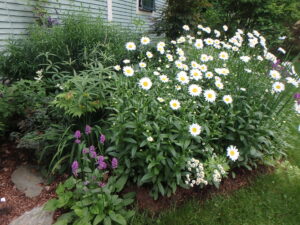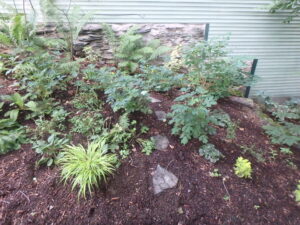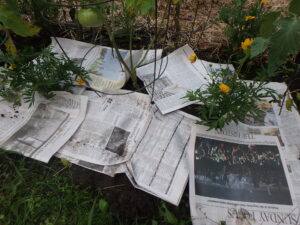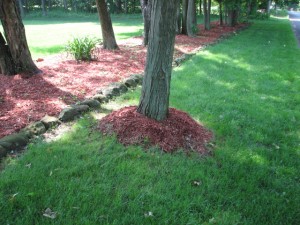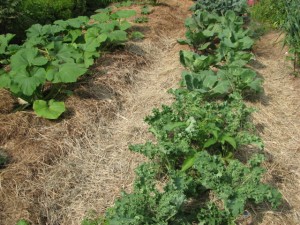Mulch Can Help Keep Down Weeds
Mulch is commonly used to help suppress weeds and to hold in soil moisture in dry times. There are many different kinds of mulch and it is important to get the right kind, and to apply it properly if you wish to get the benefits of mulch.
In addition to weed suppression, a layer of mulch keeps soils from drying out quickly in the hot summer sun. Essentially, it shades the soil, keeping it moist and cool. In the spring I do not mulch my vegetable garden until after soil temperatures have reached their summer level – say 60 degrees or more.
I always lay down two to four layers of newspaper on the ground before applying hay or straw. This accomplishes two things: it keeps light away from any weeds that germinate even with a layer of hay, and it slowly breaks down and adds more organic matter to the soil.
Planting Shrubs
Irish writer Thomas Moore (1779-1852) once wrote, “A piece of the sky and a chunk of the earth is lodged in the heart of every human being.” I would like to add “And hopes for a seed waiting to be planted”. It’s why we garden – or I do, anyway – planting, watering, tending and harvesting make me feel alive, keep my temperament balanced and give me joy.
It’s mid-October and there aren’t any seeds to be planted just now (unless you count garlic cloves as seeds). But this is a good time to plant trees and shrubs. Plants store energy from photosynthesis all summer in their roots, and then in the fall the roots use that energy to extend their range – even after leaf drop. Roots grow, apparently, until the ground freezes. Roots start growing again in the spring, and do much of their root growth in early summer.
For me, the hardest part of planting a tree or shrub is finding the proper place to plant it. I have a couple of acres, but I’ve been planting things here for over 40 years and I’m running out of space. Not only that, each tree or shrub has specific needs for sunlight exposure, moisture and soil type.
Soil is the easiest to “customize”. I can change the pH and texture or tilth pretty easily. But my back field is pretty wet, and many woody plants don’t like their roots sitting in soggy soil. With a high water table, I have to limit what I plant there. (Willows love it, and my magnolia , too.)
Sunlight is also hard to adjust. Yes, I have a chain saw, but nice trees keep on getting nicer as they grow – but creating more shade. Many nice flowering plants like full sun, which is defined as 6 hours or more of summer sun per day.
After removing a pear tree earlier this year, I had space to plant a blue hydrangea (A ‘Twist and Shout’ variety of the Endless Summer series) that had been growing in a big pot near my front door all summer. I cleared out the weeds and loosened the soil in a 5-foot circle. Then I modified the soil to meet the needs of this particular shrub: I added peat moss and garden sulfur to acidify the soil, stirring it in with my CobraHead weeder.
It’s important to get the depth of the planting hole right for trees and shrubs, much more so than for vegetables or flowers. Trees (and to a lesser degree, shrubs) can be damaged if planted too deeply, as the bark on the trunk is very susceptible to fungal rot if covered with soil or mulch. Vegetables such as tomatoes and broccoli can be planted a little deep in order to stimulate new root growth along the buried stem.
It is good to dig the hole for a tree or shrub just the depth of the root ball. After I removed my hydrangea from the pot I measured the root ball and found it to be 8 inches from surface to bottom. I dug a hole and measured the depth of it by placing the handle of a rake across the hole, and then checking it with a measuring tape. It was 6 inches at first, so I carefully scraped out 2 more inches. That allowed me to set the root ball on unexcavated soil; soil that has been dug out and replaced tends to settle – which you don’t want to happen. Sometimes, if the soil is really awful, I will dig down deeper, and then add improved soil and pack it down afterwards with my foot.
The shape of a planting hole for a tree or shrub is important. It should be flat on the bottom, and gently slope upwards toward the surface of the soil. It should be wide, not deep. A minimum width should be three times the size of your rootball, and five times is even better. Roots of most trees and shrubs go wide, not deep. Roots go out beyond the ”drip line” – the area directly under their leaves. So it is good to have nice loose soil around your tree or shrub to facilitate root growth.
Winter is not so far away. In order to allow roots to grow and develop for as long as possible, it is good to place a two-inch layer of mulch over the root zone – but no more than 2 inches. The mulch will keep the soil warm later into the fall and keep lawn mowers and those string trimmers at bay.
I’ve seen trees with what I call “mulch volcanoes” – mulch piled up deeply against the trunk of a tree. That can be a death sentence, as most bark mulch or ground branches will retain moisture and microbes that will eventually rot the cambium layer of a tree. It takes years to kill a tree with bark mulch, so many people don’t attribute the layer of mulch to the death of their tree six to ten years later. Leave a “donut hole” free of mulch around your tree to avoid that.
So go to your local garden center and buy yourself a nice tree or shrub. There is still plenty of time to plant. And I think you’ll feel a great sense of accomplishment if you do.
Henry Homeyer is a gardening teacher, coach and public speaker. Reach him at henry.homeyer@comcast.net or P.O. Box 364, Cornish Flat, NH 03746. He is happy to answer gardening questions, but please include a stamped envelope if sending a real letter.
To Mulch or Not to Mulch – and How?
For more than a month small trucks laden with chipped bark or wood chips have been scurrying around, unloading piles of mulch. Mulch (from the rich dark color of Mississippi mud to the orange hues of your grandmother’s pumpkin pie) has been spread over flower beds and piled high against the trunk of trees. It will hold down weeds and keep in moisture. But using mulch can have a downside, too. Let me explain.
It is important, if you are using a wood-based mulch, to put on a layer of an appropriate thickness. You shouldn’t just add a new layer of that pumpkin-colored mulch to last year’s mulch just because it’s dirty or the color has started to fade. You need to rake off the old mulch before applying a new layer. A gentle spring rain will not penetrate a 4-6 inch layer of mulch, and eventually the soil will dry out.
Next, there is the question of how mulch is applied near trees. Some landscapers favor the “volcano” look. While it is true that a 12-inch volcano of mulch will keep grass from growing up around your favorite crab apple tree, the mulch will eventually lead to bark rot, a compromised cambium layer, and a slow death. (Except for blueberries, which seem to thrive on mulch or sawdust piled right up to their stems).
Any wood-based, chipped mulch will eventually be host to fungi that break it down. Those same fungi will work on the bark of your tree and eventually break it down, too. Because it takes 6-12 years for a tree to decline and die from compromised bark, the cause and effect is not obvious. You can avoid the problem by leaving a donut hole around the tree – 6 inches of clear space between the trunk and the ring – the donut – of mulch.
Then there is the question of what is in your wood mulch? As a landscaper and garden designer I have occasionally needed to buy a few bags of wood mulch, even though I prefer to buy in bulk from a family-run business that makes its own. But when I do need to buy mulch, I read the label. If the mulch has been dyed with a chemical, I avoid it and go elsewhere to buy good mulch. Why? Because I am an organic gardener. It’s true that most gardeners only use wood-based mulch on flower gardens. Still, I don’t want chemicals introduced to my environment, or that of my clients.
Some years ago I visited radio personality Ray Magliozzi (of NPR’s Car Talk program) at his home in a Boston suburb. Ray was a late-comer to the organic movement. He became an organic gardener after his beloved collie died of cancer. He realized that the lawn jockeys he hired were spreading weed and fungus killers, along with their mowing and fertilizing. He questioned if there was a relationship between his dog’s illness and the chemicals. The same question could be asked about the chemical dye in mulch. What is it? How does it affect us?
So what are the alternatives to commercial wood-based mulch? My choice? Chopped leaves. Leaves run over by the lawnmower and saved last fall for use now. Trees mine minerals from the soil, and then shed their bounty to share with us each fall. Once wet, they don’t tend to blow away.
What about cocoa or buckwheat hulls? They are very tidy to look at and I’ve tried both, but they are very expensive to buy. Cocoa hulls, freshly applied, smell like chocolate chip cookies to me – and some dogs. I have heard that dogs can be sickened (or worse) by ingesting cocoa mulch (chocolate can be poisonous to dogs). That may be part urban myth, of course, but I tend to stay on the safe side. Cocoa hulls also tend to develop a slippery mold layer for a week or so, though it disappears eventually.
I use a layer of 4-6 sheets of newspaper covered with hay or straw in the walkways of my vegetable garden and around large plants, and it is effective at keeping down weeds. The inks are now soy-based and safe to use (in the old days the inks had heavy metals). I soak the papers overnight in a plastic bin first and drain the water in the driveway to get rid of any soluble chemicals in the papers.
Landscape fabric comes in many kinds. The good stuff is tough enough you can’t tear it with your hands; it allows rain to pass through, but little sunshine for hopeful weeds. My feed-n-grain store sells it by the foot, cutting it off a large wide roll, which is handy. It looks best with a thin layer of mulch on top. Black plastic is used by some in the vegetable garden, but it breaks down after a year and needs to go to the landfill. I avoid it.
Nature’s most persistent mulch is, of course, stone. I like small stones for walkways or occasionally in a flower bed. In either case, a layer of landscape fabric will do wonders for inhibiting weed growth.
So take a look around. If you see bark mulch being piled up on a tree trunk, make a citizen’s arrest. Or hand the culprit this article.
Henry Homeyer is a life-long organic gardener, gardening consultant, and UNH Master Gardener. His Web site is www.Gardening-guy.com.



